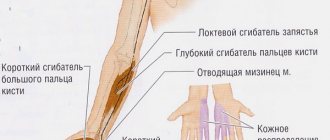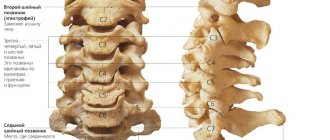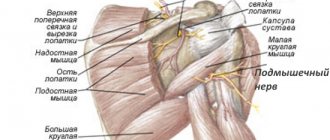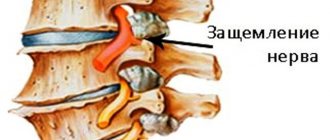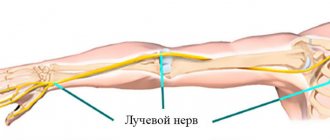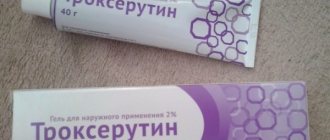A pinched nerve in the shoulder joint is a common problem. Many people confuse it with the inflammatory process, although these are two different neurological diseases that have similar symptoms. At the same time, experts note that if treatment is not timely, pinching can lead to the development of an inflammatory process. To avoid such a complication, you need to pay attention to the first symptoms and seek qualified help from a specialist.
The nerve can become pinched when bone spurs begin to appear around the spinal disc. The discs act as some kind of “shock absorbers” between the vertebrae in the spinal column. Bone spurs are new bone formations. They begin to grow when the discs weaken significantly and wear out over time. As we age, the vertebrae become compressed and the discs become thinner. Bone spurs grow around the discs to strengthen them. However, this bone growth can put negative pressure on the nerve root in the spinal column.
Causes of the disease
The sciatic nerve is the longest and most powerful in the body. This fact increases the vulnerability of the nerve process. With inflammation and swelling, it is possible that the size of an important element of the nervous system may change, thickening with further pinching in the area between the vertebrae.
When cartilage tissue degenerates, the distance between the vertebrae decreases and the nerve processes become pinched. When muscles spasm, the pathological process progresses and pain occurs more frequently.
The main causes of inflammation of the sciatic nerve:
- osteochondrosis in the lumbosacral region;
- development of Schmorl's hernia;
- heavy physical activity;
- consequence of hypothermia;
- metabolic disorders due to stress;
- bulging intervertebral discs;
- tumors and tuberculosis in the lumbar area (less commonly).
Look at a selection of effective methods for treating dorsopathy of the lumbosacral spine.
How to treat lumbar spondyloarthrosis? Effective treatment options are described in this article.
Pathologies in which pain often radiates to the leg:
- lumbago. The disease develops against the background of hypothermia, lifting heavy loads;
- lumbarization. Anomaly of the development of the spinal column. The child is born with a defect: the photographs show fusion of the vertebrae, a decrease in the number of bone structures in the lumbosacral area;
- sciatica or sciatica. The pathology develops against the background of damage to the sciatic nerve. Severe discomfort with painful shooting in the legs is a characteristic sign of the disease;
- lumbodynia. Pain syndrome is a consequence of abrasion of intervertebral discs under high loads, damage to the vertebrae due to impacts, falls, after an accident;
- sciatica. Acute pain pierces the lower back with severe muscle overload. Frequent lifting of weights, especially if the norms are not followed, causes a recurrence of painful manifestations; lumbago radiates to the buttocks, groin, and lower extremities.
Previously, doctors observed pinched nerves in the spine with pronounced pain syndrome in elderly people against the background of degenerative-dystrophic processes. Nowadays, young people suffering from similar symptoms often come to see an orthopedic traumatologist, vertebrologist and neurologist. A sedentary lifestyle or high loads, “rejuvenation” of many spinal pathologies are dangerous factors that disrupt the lives of people of working age.
Causes of a pinched nerve in the shoulder
A pinched nerve can occur for several reasons, but it occurs when a nerve fiber is compressed by nearby tissue. As a result, the nerve bundle may become inflamed, leading to swelling. In most cases, the lesion affects the axillary, radial and median nerves. Among the most common factors that provoke the appearance of the disease are:
- degenerative-dystrophic diseases of the spinal column (in particular, osteochondrosis and arthrosis);
- complex diseases of the musculoskeletal system (for example, herniated discs);
- abnormalities in the functioning of the endocrine system (obesity). Excess weight puts increased pressure on muscles and nerves, which significantly increases the likelihood of illness;
- rheumatoid arthritis. The disease damages nerves over time, increasing the risk of pinching. The resulting bone spurs can lead to limited space for the nerves of the shoulder, which provokes the disease;
- various injuries (bruises, dislocations, fractures);
- prolonged walking on crutches;
- pathologies of the central nervous system;
- sedentary lifestyle;
- inflammation of the synovial bursa (bursitis);
- connective tissue dysplasia;
- excessive physical stress on the shoulder during sports;
- unsuccessful injections into the shoulder joint;
- infectious pathologies (for example, tuberculosis and syphilis);
- neoplasms in the shoulder and armpit area (both benign and malignant);
- damage to the acromial joint;
- increased and prolonged load on the shoulder joint;
- chronic lead poisoning;
- complications after surgical interventions (presence of adhesions or scars).
Forms of lumboischialgia
The disease often develops with excessive load on the lumbar area. Severe pain is the main symptom of all types of pathologies, against the background of which painful symptoms develop. The pain radiates to the leg strictly along the course of the inflamed nerve: through the gluteal area, the back of the thigh, then branches, descends along the back of the lower leg to the plantar area of the foot.
The predominance of certain symptoms characterizes one of the forms of lumboischialgia:
- neurodystrophic. A characteristic symptom is increased pain at night. Disruption of metabolic processes occurs not only in nerve fibers: in the neurodystrophic form of lumboischialgia, the skin is affected. The patient notices a thinning of the epidermis on the legs; in advanced cases, long-term non-healing ulcers may appear near the ankle joint;
- vegetative-vascular. The patient not only experiences acute pain, but also feels numbness in the limbs. When the patient gets up in the morning after waking up or resting in bed during the day, the discomfort in the lumbar area intensifies and the pain syndrome worsens. The greatest degree of damage was noted on the foot from the side of the problematic nerve: the area is cold and pale. Vascular disorders cause other unpleasant manifestations: decreased sensitivity, “goosebumps” under the skin, flashes of cold or heat;
- muscular-tonic. A characteristic symptom is a sharp limitation of movements, curvature of the spine forward (lordosis) or to the side (scoliosis). Deformation of the spinal column negatively affects the functioning of the internal organs and the appearance of the patient. Muscle spasm in the lower extremities and lower back provokes acute pain; combination with spinal curvature enhances negative symptoms.
On a note! The “pure” form of the disease appears rarely; a combined type of pathology develops more often. The combination of different forms enhances negative manifestations and complicates diagnosis.
ethnoscience
The course of therapy should consist of several methods, since it is not easy to cure a pinched nerve. Traditional recipes have helped many people solve this problem and have become an excellent addition to the main treatment regimen. Among its methods are the following:
- Tincture of bay leaves. The main ingredient should be crushed, and then 30 g of the resulting mixture should be poured into 200 ml of vodka or alcohol. The resulting product should be placed in a dark place for 3 days, after which it can be used to rub the lower back;
- Hop cones. To prepare the ointment for rubbing, you need to mix 1 tbsp. l. crushed and dried main ingredient with the same amount of butter. This homemade ointment is used to rub the back;
- Lilac buds. You need to make a decoction of them and then mix them with butter. You can rub the lower back with the prepared mixture.
A pinched nerve in the spine is an extremely painful process. However, often this problem goes away without a trace if you correctly formulate a course of therapy and strictly follow the doctor’s instructions. To do this, you should undergo a detailed diagnosis to exclude pathologies with similar symptoms and identify the cause of nerve compression.
First signs and symptoms
The main symptom of a pinched nerve in the back is severe pain radiating to the leg. It is easy to trace the location of the affected nerve fiber by the movement of pain sensations.
Primary signs:
- paroxysmal, aching, acute or quickly passing pain;
- lumbago in the lower extremities, gluteal region, groin;
- it seems that “goosebumps” are crawling up your legs;
- the lower limbs become numb, blood circulation is impaired, the feet are cold and insensitive.
Secondary signs:
- pain in other parts of the back, arms, shoulder girdle, pelvic area;
- an increase in temperature during an active inflammatory process.
Symptoms: how does pathology manifest itself?
The pinched nerve of the wrist does not affect the motor function of the entire arm; the limb rises and falls freely and is abducted to the sides.
In the area of the wrist joint there is a section of the nerve branch that provides sensitivity and moves the limb. If the nerve is pinched, the following signs appear:
- aching, persistent, shooting pain radiating to the shoulder, elbow or fingers,
- muscle weakness, especially when trying to grasp or hold an object,
- partial or complete loss of motor functions,
- a feeling of numbness of the skin or tingling in the phalanges.
Diagnostics
To identify the root cause of the pain syndrome and clarify the type and stage of the pathology, the patient should make an appointment with a neurologist or orthopedic traumatologist. If there is a vertebrologist in your locality, you can contact a specialist who deals with pathologies of the musculoskeletal system.
It is important to exclude damage to internal organs, gynecological diseases, and the development of a tumor process. The patient undergoes a blood test, an X-ray of the spine and a magnetic resonance imaging scan.
What to do if a nerve is pinched and the pain radiates to the leg
Very often, a paroxysm of pain occurs suddenly, plunging a person into a state of shock and confusion. Emergency care includes several actions. First, you must immediately take a horizontal position and lie down on a flat surface. It should not be cold, too hard or soft.
If possible, you need to find the most favorable body position in which the least pain is felt, and limit any movements. Most patients feel better when a bolster or pillow is placed under their knees.
Then it is recommended to drink any painkiller - Baralgin, Dexalgin or Nise. Tempalgin, which contains not only the analgesic metamizole sodium, but also an anxiolytic component (tranquilizer), has a good effect. Additionally, you can take a mild sedative - for example, tincture of valerian or motherwort.
Any anti-inflammatory ointment that can be found in a home medicine cabinet will help relieve or at least reduce pain - Aertal, Dolobene, Fastum-gel, etc. Ointments and gels based on Diclofenac and Ibuprofen also have a pronounced analgesic effect.
To immobilize (immobilize) the damaged segment of the spine, you can use an orthopedic corset or a support bandage. If they are absent, it is enough to wrap a warm scarf or elastic bandage around your lower back.
The most important therapeutic measure for lumbago is kyphosis, that is, straightening the lumbar lordosis. The patient should lie either on his back with a bolster placed under his knees, or on his stomach, under which a pillow is placed.
Note: clinical manifestations of pinched nerve roots are often transient and go away on their own after some time. This does not always mean recovery, and the pain can return at any time.
It is important to know that if you have severe pain in the lower back, radiating to the leg, you cannot carry out thermal procedures and massage, as well as practice traditional methods. All these actions can be beneficial only after acute symptoms have been relieved and the cause of the pain has been established.
General rules and methods of treatment
How to treat a pinched nerve in the lower back? Problems with the lower spine need to be solved before the pathology reaches an irreversible stage. It is not enough to relieve pain with powerful analgesics: pinched nerves and the inflammatory process do not disappear from the use of painkillers, and the discomfort intensifies.
Doctors try to avoid surgery and offer the patient conservative treatment. It requires taking several types of medications, undergoing physical therapy, visiting a chiropractor, and performing special exercises.
Warning! Injections of potent drugs over a long period of time have a negative effect on many systems. Uncontrolled application of ointments gives a temporary effect; inflammation and pinching of the sciatic nerve does not cure.
Medications
Medications for lower back pain:
- non-steroidal anti-inflammatory drugs. Movalis, Nise, Nurofen, Ibuprofen, Ketoprofen, Voltaren Retard, Dolobene, Diclofenac, Finalgel, Ketorolac. The drugs have a negative effect on the delicate mucous membranes of the digestive organs: all formulations, even for external use, should be used only after meals;
- compounds that relieve muscle spasms. Mydocalm, Myocaine, Baclofen. The doctor selects the optimal drug that combines well with NSAID drugs;
- blockade using one, two or three components to relieve excruciating pain. For injections, the main ingredients with active analgesic and anti-inflammatory effects are used. Local anesthetics are effective: Mercaine, Lidocaine, Novocaine, corticosteroids: Kenalog, Diprospan, Hydrocortisone, Depo-Medrol, Dexamethasone. Additional components to enhance the effect of active substances: papain, ATP, platifillin, rumalon, thrombolysin, lidase. Blockades have contraindications, in particular, pregnancy, bleeding tendency, and renal failure.
Additional Therapy Options
Other methods of treating pinched nerves in the lumbar area:
- manual therapy;
- treatment using a traction couch;
- acupuncture;
- physiotherapy: diadynamic currents, magnetic and amplipulse therapy, phonophoresis, therapeutic massage;
- gymnastics and exercises for pinching the sciatic nerve to develop the affected area after eliminating the pronounced pain syndrome;
- applying homemade ointments to problem areas with an analgesic and warming effect. All folk remedies can be used only with the permission of a vertebrologist or neurologist. Application of inappropriate compounds increases the inflammatory process and worsens the patient's condition.
Find out why your back hurts between your shoulder blades and how to get rid of the pain.
The symptoms of a lumbar hernia and effective treatment options for the formation are written on this page.
Go to the address and read about treating spinal hemangioma with folk remedies at home.
Treatment: how to proceed correctly?
Drug therapy
If a nerve is pinched in the wrist joint, doctors recommend the following medications to relieve neuralgic pain and inflammation:
- "Ibuprofen";
- "Naproxen";
- "Gabapentin";
- "Pregabalin";
- "Movalis";
- "Voltaren";
- "Arcoxia";
- "Nimesulide".
To stimulate metabolic processes in nerve cells, it is recommended to consume B vitamins. It is useful to take chondroprotectors, which help restore the cartilage tissue of the joints of the hand. All medications must be prescribed by a doctor; self-medication is dangerous. If drug treatment is ineffective, surgery is prescribed to free the pinched nerve.
Physiotherapy methods
Already after the first procedure, the mobility of the limb is restored.
You can eliminate a pinched nerve in your hand or finger using the following physiotherapeutic procedures:
- magnetic therapy;
- laser therapy;
- electrophoresis;
- thermal wraps with ozokerite or paraffin;
- inductothermy;
- massage;
- osteopathy - finger pressure on active points;
- manual therapy.
Preventive recommendations
Patients who have experienced symptoms of lumbago, sciatica, lumbar sciatica, and other conditions associated with pinched nerves know how painful attacks can be. Doctors recommend protecting the spine and back muscles and not provoking the development of negative symptoms in order to avoid acute pain radiating to the leg, buttocks, and groin.
Prevention measures:
- Avoid drafts and hypothermia.
- Women are less likely to wear high heels.
- Lift the load correctly, do not exceed the norm for a certain age and body weight.
- Do not make sudden movements; when bending to the sides, forward and backward, calculate the optimal amplitude.
- Eat nutritiously, get enough collagen, vitamins and microelements, do not overuse salt.
- Drink strong coffee, carbonated drinks, alcohol, sour juices and fruits less often.
- During high physical activity, wear a special belt or corset that supports the spinal column, protecting the muscles from overstrain.
- Control body weight: every extra kilogram negatively affects the vertebrae and cartilage.
- Do gymnastics, strengthen the muscle corset, maintain the elasticity of cartilage, and the flexibility of the spine.
- During pregnancy, avoid excessive stress, carrying heavy bags, and wear a special bandage with a supporting effect.
If you have a pinched nerve, lower back pain, or painful shooting pain, you should not self-medicate. You will need the help of an experienced doctor, a set of drugs and procedures to get rid of acute symptoms. It is necessary to understand the causes of the negative phenomenon, study preventive measures so as not to encounter damage to the spine and muscles.
The following video shows an effective exercise for acute pain, which quickly relieves pinched sciatic nerve in the lumbar region:
Clinical picture
Symptoms of a pinched nerve:
- partial or complete loss of movement;
- muscle weakness;
- burning;
- sharp or aching pain;
- numbness;
- tingling.
Pathology is divided into types, depending on what type of nerve was pinched:
- Long-term use of hand-held vibrating tools provokes the development of carpal tunnel syndrome. This is a neurological disease characterized by pinching of the median nerve, which is located between the bones of the wrist. The main symptoms are deterioration in the sensitivity of the fingers, acute persistent pain, and the inability to bend the hand into a fist.
- When the ulnar nerve is damaged, aching pain appears and sensitivity in the fingers disappears.
- With radial neuropathy (damage to the radial nerve), it is impossible to bend the hand, mobility is limited or absent, and the appearance of “dangling hand syndrome” is characteristic.
Read also... Pinched brachial nerve: a small nuisance or a serious pathology?

